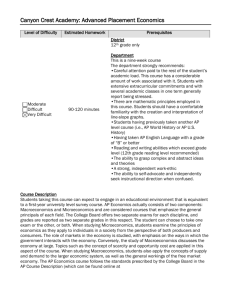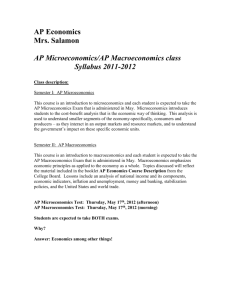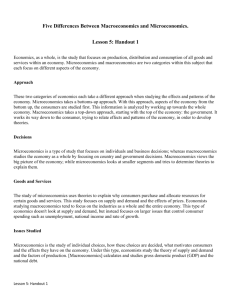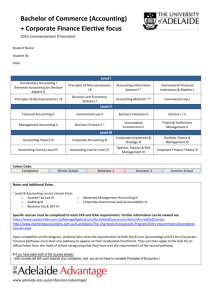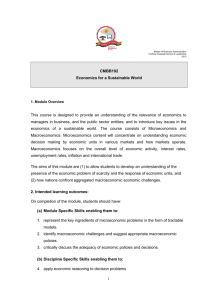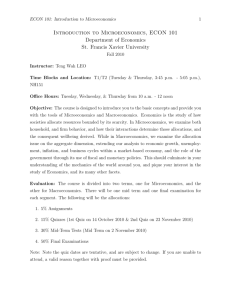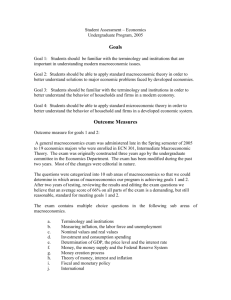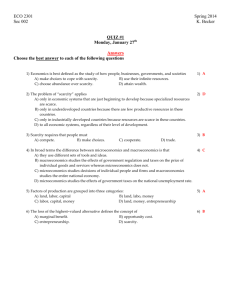TAMALPAIS UNION HIGH SCHOOL DISTRICT
advertisement
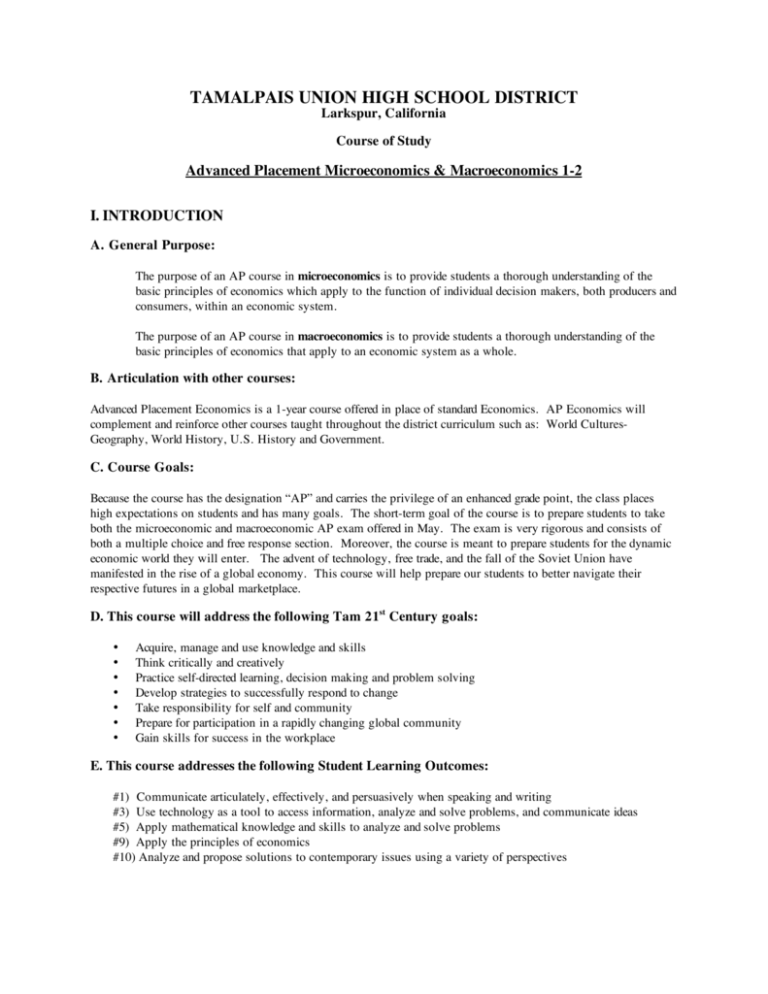
TAMALPAIS UNION HIGH SCHOOL DISTRICT Larkspur, California Course of Study Advanced Placement Microeconomics & Macroeconomics 1-2 I. INTRODUCTION A. General Purpose: The purpose of an AP course in microeconomics is to provide students a thorough understanding of the basic principles of economics which apply to the function of individual decision makers, both producers and consumers, within an economic system. The purpose of an AP course in macroeconomics is to provide students a thorough understanding of the basic principles of economics that apply to an economic system as a whole. B. Articulation with other courses: Advanced Placement Economics is a 1-year course offered in place of standard Economics. AP Economics will complement and reinforce other courses taught throughout the district curriculum such as: World CulturesGeography, World History, U.S. History and Government. C. Course Goals: Because the course has the designation “AP” and carries the privilege of an enhanced grade point, the class places high expectations on students and has many goals. The short-term goal of the course is to prepare students to take both the microeconomic and macroeconomic AP exam offered in May. The exam is very rigorous and consists of both a multiple choice and free response section. Moreover, the course is meant to prepare students for the dynamic economic world they will enter. The advent of technology, free trade, and the fall of the Soviet Union have manifested in the rise of a global economy. This course will help prepare our students to better navigate their respective futures in a global marketplace. D. This course will address the following Tam 21st Century goals: • • • • • • • Acquire, manage and use knowledge and skills Think critically and creatively Practice self-directed learning, decision making and problem solving Develop strategies to successfully respond to change Take responsibility for self and community Prepare for participation in a rapidly changing global community Gain skills for success in the workplace E. This course addresses the following Student Learning Outcomes: #1) Communicate articulately, effectively, and persuasively when speaking and writing #3) Use technology as a tool to access information, analyze and solve problems, and communicate ideas #5) Apply mathematical knowledge and skills to analyze and solve problems #9) Apply the principles of economics #10) Analyze and propose solutions to contemporary issues using a variety of perspectives II. STUDENT LEARNING OUTCOMES A. Students will: 1. 2. 3. 4. B. Students will be prepared to earn a passing score, 3 or better, on the College Board AP Microeconomics and Macroeconomics exam. Students will learn the foundation of economic theory through the study of microeconomics. This will include reading articles, solving problems using graphs, and analyzing current events. Students will learn the foundation of macroeconomic theory primarily by studying current events. For example, throughout the course students will monitor stock market activity, economic growth rates, federal tax policy, unemployment, inflation and monetary policy. Students will be tested in both a multiple choice and short answer format which resembles the AP Testing format. Students will cover the following state subject Content Standards: a. b. c. d. e. f. g. C. Introduction to Economics and Economic Systems (12.1) How economic decisions are made in societies that face scarcity Aggregate Behavior of the American Economy: Interpretation of Indicators and Data (12.5) The Role of the Government in the Economy (12.3.3) Introduction to Fiscal and Monetary Policy Theory as use in counter-cyclical measures Income Distribution in the United States and the Implications of the Unequal Distribution of Income(12.4.3) The United States Labor Market (12.4) The Market Based Economy (12.2) Using Supply and Demand and Free Market Forces to Understand our American Economy Trade and Global Development (12.6) Personal Finance Course Content I. Microeconomics: a. Scarcity, choice, and opportunity cost b. Production Possibilities Curve c. Economic Systems d. Supply & Demand e. Elasticity f. Total Utility & Marginal Utility g. Firm Behavior and Market Structures h. Market Failure and the role of Government i. Negative Externalities II. Macroeconomics a. Circular Flow of Economy b. Gross Domestic Product c. Inflation, Employment d. Aggregate Supply & Aggregate Demand e. Central Banks & Monetary Policy f. Federal Government and Fiscal Policy g. Economic Growth and Productivity h. International Trade and Finance III. ASSESSMENT A. Student Assessment Students will be assessed on the learning outcomes primarily via multiple choice and short answer exams. Project-based assessments will be incorporated whenever it is possible and efficient. In addition, current event essays, homework questions, and oral presentations may all be forms of assessment throughout the course B. Course Assessment Students are expected to complete both the microeconomics and macroeconomics AP exam at the end of the course. IV. METHODS AND MATERIALS A. Methods A variety of strategies will be used to implement the curriculum and address the student outcomes mentioned above. This may include discussions, reading and analysis, lectures, research projects, simulations and guest speakers. B. Materials The course will use one primary textbook which will cover both microeconomics and macroeconomics. The textbook will be “The Principles of Economics” by Gregory Mankiw Other resources may be used including current event articles from newspapers, magazines, and other sources of economic information. In addition, streaming media, various CDs/VHS recordings, and power point slides will be employed. C. Technology Streaming media, various CDs/VHS recordings and power point slides will be employed throughout the course. In addition, a live stock trading simulation is also expected to be incorporated. D. School to Career Goals The course will prepare students for the work world by studying current labor market conditions and the changing role of the United States in the global economy. Guest speakers may be used as appropriate. E. Suggested Instructional Time Allocation The course will be divided into 1 semester of microeconomics and 1 semester of macroeconomics. The course is expected to cover the entire textbook over the course of one school year. V. GENERAL INFORMATION AP Microeconomics and Macroeconomics is a 10 credit course open to qualified seniors based the criteria listed below. A. Prerequisites This course is intended seniors who have shown above average aptitude in both Social Studies and Mathematics. Required Criteria: Seniors have completed or are concurrently enrolled in Advanced Algebra 1-2. Placement Criteria: Placement into AP Economics will be based on required criteria and recommendations from student’s Junior year math and social studies teachers. Required Skills: Graphing skills are imperative for student success. All mathematical computations on the AP Exam must be done without the use of a calculator. B. Requirements Met 1.This course provides 10 total units of credit for the school year. 2.Each semester is divided into 2.5 units of required credit and 2.5 units of elective credit. 3.Therefore a student must complete both semesters to achieve the required 5 units credit for graduation. 4. It has been accepted by UC towards the "g" requirement. C. Estimated Implementation Costs 1. 2. 3. 4. 55 books at $130/each: Summer Work: (35hr * 10hrs * 2 staff) Other: workshop, videos, etc TOTAL: Board Adopted: 3/28/06 $7,150 $700 $1,000 $8,850

